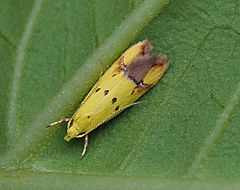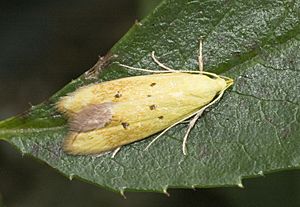Gymnobathra flavidella facts for kids
Quick facts for kids Gymnobathra flavidella |
|
|---|---|
 |
|
| Scientific classification | |
| Kingdom: | |
| Phylum: | |
| Class: | |
| Order: | |
| Family: |
Oecophoridae
|
| Genus: | |
| Species: |
G. flavidella
|
| Binomial name | |
| Gymnobathra flavidella (Walker, 1864)
|
|
| Synonyms | |
|
|
The Gymnobathra flavidella is a small moth that belongs to the Oecophoridae family. This special moth lives only in New Zealand. Its caterpillars (larvae) like to eat plants like Brachyglottis repanda and Gahnia procera.
Contents
Discovering the Moth
This moth was first described by a scientist named Francis Walker. He gave it its first scientific name, Gelechia flavidella, in 1864.
What Does It Look Like?
The front wings of this moth are usually between 4.5 and 8.5 millimeters long. That's about the length of a few grains of rice!
Another scientist, G.V. Hudson, described the moth's appearance in more detail:
The wings can spread out from a little over 1/2 inch to almost 3/4 inch wide. The front wings are bright yellow with markings that are a rosy-brown color. There's a tiny mark near the base of the wing and some faint shading at the tip. You might also see three dark brown dots on the wing. A noticeable triangular patch of rosy-brown is found near the bottom corner of the wing. This patch has a dark line next to it that fades towards the top of the wing. The back wings are white, but their edges are often clouded with a light rosy-brown color. The tiny hairs (cilia) on all the wings are also rosy-brown. Some moths might have front wings that are more orange-brown, and their size can vary quite a bit.
Where Does It Live?
This moth is found only in New Zealand. It is quite common in many parts of the North Island. You can also find it in the upper half of the South Island, reaching as far south as Christchurch and Franz Josef.
What Do Its Caterpillars Eat?
The young caterpillars of Gymnobathra flavidella live inside and feed on the Brachyglottis repanda plant. Another plant, Gahnia procera, has also been noted as a food source for these caterpillars.


